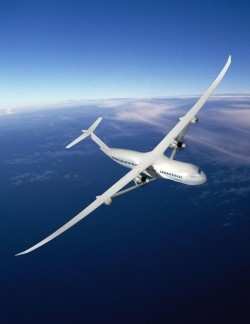Sat, Dec 11, 2010
Contract For Research Into Cleaner, More Fuel-Efficient
Airliners
NASA has awarded a third contract for studies designed to
identify advanced concepts for airliners that could enter service
in 2025, fly with less noise, cleaner exhaust and lower fuel
consumption. NASA refers to technology that is two generations more
advanced than what is on aircraft in service today as N+2.

File Image
A team led by The Boeing Company of Huntington Beach, CA, was
selected for a contract worth $5.29 million. The contract has a
performance period of one year beginning this month. As part of the
same research effort, NASA previously awarded contracts worth $2.99
million and $2.65 million to teams led by Lockheed Martin in
Palmdale, CA, and Northrop Grumman in El Segundo, CA.
A key objective of the N+2 research is to ensure the
technological elements proposed for meeting NASA's noise, emissions
and fuel burn reduction goals can be integrated on a single
aircraft that could operate safely within a modernized air traffic
management system. The research contracts will identify innovations
that will provide the necessary technologies to industry for
development and flight demonstrations to support entry into service
in the 2025 time frame. The Boeing team will define a preferred
system concept for an aircraft that can achieve speeds up to 85
percent of the speed of sound, cover a range of nearly 7,000 miles
and carry between 50,000 and 100,000 pounds of payload, either
passengers or cargo.

NASA's Environmentally Responsible Aviation Project sponsors the
studies. The project is part of the Integrated Systems Research
Program managed by the agency's Aeronautics Research Mission
Directorate in Washington. The project is working to develop
technology that would enable future aircraft to burn 50 percent
less fuel than today's most efficient models, with 50 percent fewer
harmful emissions; and to shrink the size of geographic areas
affected by objectionable airport noise by 83 percent.
More News
Pilot Also Reported That Due To A Fuel Leak, The Auxiliary Fuel Tanks Were Not Used On June 4, 2025, at 13:41 eastern daylight time, a Piper PA-23, N2109P, was substantially damage>[...]
Have A Story That NEEDS To Be Featured On Aero-News? Here’s How To Submit A Story To Our Team Some of the greatest new stories ANN has ever covered have been submitted by our>[...]
From 2023 (YouTube Edition): Reflections on War’s Collective Lessons and Cyclical Nature The exigencies of war ought be colorblind. Inane social-constructs the likes of racis>[...]
Aero Linx: Colorado Pilots Association (CPA) Colorado Pilots Association was incorporated as a Colorado Nonprofit Corporation in 1972. It is a statewide organization with over 700 >[...]
High Speed Taxiway A long radius taxiway designed and provided with lighting or marking to define the path of aircraft, traveling at high speed (up to 60 knots), from the runway ce>[...]
 NTSB Prelim: Piper PA-23
NTSB Prelim: Piper PA-23 ANN FAQ: Submit a News Story!
ANN FAQ: Submit a News Story! Classic Aero-TV: One Mans Vietnam
Classic Aero-TV: One Mans Vietnam ANN's Daily Aero-Linx (07.03.25)
ANN's Daily Aero-Linx (07.03.25) ANN's Daily Aero-Term (07.03.25): High Speed Taxiway
ANN's Daily Aero-Term (07.03.25): High Speed Taxiway




